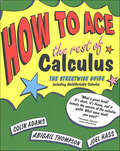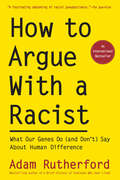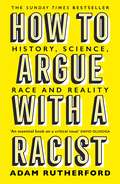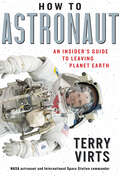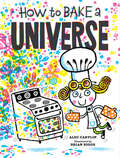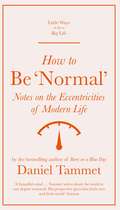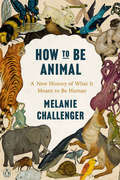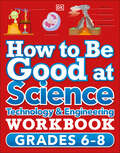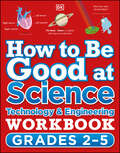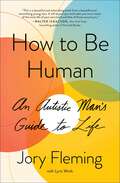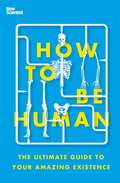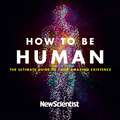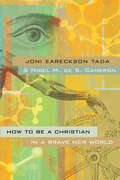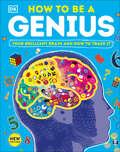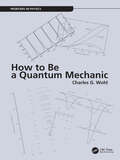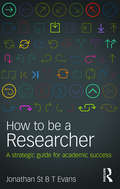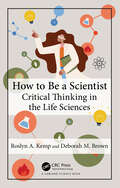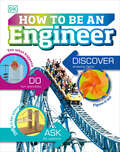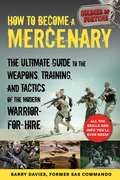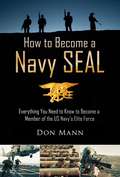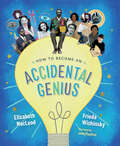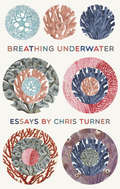- Table View
- List View
How things work (Readers Are Leaders Ser.)
by Elizabeth Eagar Connie SeptemberHome Language Grade 5 Graded Reader
How to Ace the Rest of Calculus: The Streetwise Guide (How to Ace)
by Joel Hass Colin Adams Abigail ThompsonThe sequel to How to Ace Calculus, How to Ace the Rest of Calculus provides humorous and highly readable explanations of the key topics of second and third semester calculus-such as sequences and series, polor coordinates, and multivariable calculus-without the technical details and fine print that would be found in a formal text.
How to Argue With a Racist (and Don't) Say About Human Difference: What Our Genes Do (and Don't) Say About Human Difference
by Adam RutherfordThis authoritative debunking of racist claims that masquerade as “genetics” is a timely weapon against the misuse of science to justify bigotry—now in paperback Race is not a biological reality. Racism thrives on our not knowing this. In fact, racist pseudoscience has become so commonplace that it can be hard to spot. But its toxic effects on society are plain to see: rising nationalism, simmering hatred, lost lives, and divisive discourse. Since cutting-edge genetics are difficult to grasp—and all too easy to distort—even well-intentioned people repeat stereotypes based on “science.” But the real science tells a different story: The more researchers learn about who we are and where we come from, the clearer it becomes that our racial divides have nothing to do with observable genetic differences. The bestselling author of A Brief History of Everyone Who Ever Lived explains in this explosive, essential guide to the DNA we all share.
How to Argue With a Racist: History, Science, Race and Reality
by Adam RutherfordTHE SUNDAY TIMES BESTSELLER'Nobody deals with challenging subjects more interestingly and compellingly than Adam Rutherford, and this may be his best book yet. This is a seriously important work' BILL BRYSON'A fascinating and timely refutation of the casual racism on the rise around the world. The ultimate anti-racism guide for data-lovers everywhere' CAROLINE CRIADO PEREZ ***Race is real because we perceive it. Racism is real because we enact it. But the appeal to science to strengthen racist ideologies is on the rise - and increasingly part of the public discourse on politics, migration, education, sport and intelligence. Stereotypes and myths about race are expressed not just by overt racists, but also by well-intentioned people whose experience and cultural baggage steer them towards views that are not supported by the modern study of human genetics. Even some scientists are uncomfortable expressing opinions deriving from their research where it relates to race. Yet, if understood correctly, science and history can be powerful allies against racism, granting the clearest view of how people actually are, rather than how we judge them to be.HOW TO ARGUE WITH A RACIST is a vital manifesto for a twenty-first century understanding of human evolution and variation, and a timely weapon against the misuse of science to justify bigotry.
How to Astronaut: An Insider's Guide to Leaving Planet Earth
by Terry Virts"There's something intriguing to be learned on practically every page... [How to Astronaut] captures the details of an extraordinary job and turns even the mundane aspects of space travel into something fascinating."––Publishers Weekly Ride shotgun on a trip to space with astronaut Terry Virts. A born storyteller with a gift for the surprising turn of phrase and eye for the perfect you-are-there details, he captures all the highs, lows, humor, and wonder of an experience few will ever know firsthand. Featuring stories covering survival training, space shuttle emergencies, bad bosses, the art of putting on a spacesuit, time travel, and much more!
How to Bake a Universe
by Alec CarvlinThis whimsical and informed debut picture book takes a leaf from a cookbook to show readers how the universe came into being. To bake a universe, you’ll need a heaping pile of nothing. That’s right, not a single thing! Just make sure you have enough . . . Alec Carvlin breaks down the Big Bang into the steps of a recipe, from the formation of quarks and atoms (preheat your oven to Absolute Hot) to the compression of gases into stars and planets (just set your timer for 180 million years). Carvlin expertly balances mind-boggling facts with snappy storytelling, and Brian Biggs’s bold and contagiously cheerful illustrations bring the infinite down to the bite-sized. How to Bake a Universe is an accessible and playful authority on the formation of the universe and a heartfelt commentary on how to live in it.
How to Be 'Normal': Notes on the eccentricities of modern life
by Daniel TammetAn eye-opening short book by the international bestselling writer of Born on a Blue Day and Thinking in Numbers.Have you ever wondered how neurotypicals - so called 'normal' people - come across to those who are on the autistic spectrum? What would an instruction manual about being an average human being look like to them? And actually, would it be that different, fundamentally, to a field guide about autistic people (were such a thing to exist)?Daniel Tammet is an essayist, poet, novelist and translator. In 2004, he was diagnosed with high-functioning autistic savant syndrome. In this eye-opening and fascinating book, he takes readers on a tour around nightclubs, ponders the significance of tattoos, delves into anti-age creams and puzzles over playing the lottery, all from the perspective of someone who approaches everything in life from a unique angle. After all, this is a man for whom Wednesdays are always blue, who sees numbers as shapes and who learned conversational Icelandic from scratch in seven days.These short essays come together in a beautifully written, sometimes humorous but always refreshing narrative that focuses on the eccentricities of modern life as seen through the eyes of someone always on the outside. Rather wonderfully, it illustrates the eccentricity inherent in every kind of mind, reminding us of the little-noticed strangeness of our common humanity, while subtly questioning what it means to be thought 'normal'.
How to Be 'Normal': Notes on the eccentricities of modern life (Little Ways to Live a Big Life #5)
by Daniel TammetAn eye-opening short book by the international bestselling writer of Born on a Blue Day and Thinking in Numbers.Have you ever wondered how neurotypicals - so called 'normal' people - come across to those who are on the autistic spectrum? What would an instruction manual about being an average human being look like to them? And actually, would it be that different, fundamentally, to a field guide about autistic people (were such a thing to exist)?Daniel Tammet is an essayist, poet, novelist and translator. In 2004, he was diagnosed with high-functioning autistic savant syndrome. In this eye-opening and fascinating book, he takes readers on a tour around nightclubs, ponders the significance of tattoos, delves into anti-age creams and puzzles over playing the lottery, all from the perspective of someone who approaches everything in life from a unique angle. After all, this is a man for whom Wednesdays are always blue, who sees numbers as shapes and who learned conversational Icelandic from scratch in seven days.These short essays come together in a beautifully written, sometimes humorous but always refreshing narrative that focuses on the eccentricities of modern life as seen through the eyes of someone always on the outside. Rather wonderfully, it illustrates the eccentricity inherent in every kind of mind, reminding us of the little-noticed strangeness of our common humanity, while subtly questioning what it means to be thought 'normal'.
How to Be Animal: A New History of What It Means to Be Human
by Melanie Challenger&“A brilliant, thought-provoking book.&” —Matt Haig, New York Times bestselling author of The Midnight Library A wide-ranging take on why humans have a troubled relationship with being an animal, and why we need a better oneHuman are the most inquisitive, emotional, imaginative, aggressive, and baffling animals on the planet. But we are also an animal that does not think it is an animal. How well do we really know ourselves?How to Be Animal tells a remarkable story of what it means to be human and argues that at the heart of our existence is a profound struggle with being animal. We possess a psychology that seeks separation between humanity and the rest of nature, and we have invented grand ideologies to magnify this. As well as piecing together the mystery of how this mindset evolved, Challenger's book examines the wide-reaching ways in which it affects our lives, from our politics to the way we distance ourselves from other species. We travel from the origin of homo sapiens through the agrarian and industrial revolutions, the age of the internet, and on to the futures of AI and human-machine interface. Challenger examines how technology influences our sense of our own animal nature and our relationship with other species with whom we share this fragile planet.That we are separated from our own animality is a delusion, according to Challenger. Blending nature writing, history, and moral philosophy, How to Be Animal is both a fascinating reappraisal of what it means to be human, and a robust defense of what it means to be an animal.
How to Be Good at Science, Technology and Engineering Workbook, Grade 6-8 (DK How to Be Good at)
by DKGain a complete understanding of Grades 6, 7 and 8 STEM subjects.From atoms and rocketships to vaccines and the human nervous system, this fully illustrated home learning workbook will help your child be at the top of their science class!This engaging science book for kids makes tricky topics and challenging concepts completely crystal clear! Here&’s what&’s inside: • Covers the core STEM topics, from biology, chemistry and physics, to technology. • Clearly laid out with easy-to-follow instructions for children to use by themselves. • Answers are given at the back of the book. • Practice questions and practical exercises to help expand your child&’s knowledge of the subject. Take your child&’s STEM learning to the next levelDid you know that many plants have a transport system to carry water and nutrients wherever they are needed? Or that most power stations around the world burn fossil fuels to make electricity? Packed with fascinating facts, fun graphics and step-by-step explanations, this brilliant visual workbook makes understanding science, technology and engineering super simple! It&’s perfect for extra science revision practice before an important test. Perfect for children ages 11-14, this colorful science practice book covers all the key areas of the school curriculum for this level. It includes genes and DNA, molecules, chemical reactions, the periodic table, heat transfer, electricity and magnetism, seasons and climate zones, and lots more. And there are answers at the back to check that you're on the right path.This engaging and clear science workbook accompanies How to be Good at Science, Technology, and Engineering Grade 2-5 which covers ages 7-11 (Grades 2, 3, 4 and 5).Discover How to be Good at other subjectsDK&’s successful How to be Good at... workbook series provides your child with the tools to learn how to look at the world around them and figure out how it works. There are more books to discover! Learn everything they need to know about math through eye-catching illustrations and easy-to-follow instructions with How to Be Good at Math.
How to Be Good at Science, Technology and Engineering Workbook, Grades 2-5 (DK How to Be Good at)
by DKHelp your child master Grade 2 to 5 STEM subjects and become a science superstar!From learning how the heart works to understanding what evolution is, this fully illustrated home learning workbook makes grasping science, technology and engineering as easy as ABC.This engaging science book for kids makes tricky topics and challenging concepts completely crystal clear! Here&’s what&’s inside: • Covers the core STEM topics for grades 2-5, from biology, chemistry and physics to technology. • Clearly laid out with easy-to-follow instructions for children to use by themselves. • Answers are given at the back of the book. • Practice questions and practical exercises to help expand your child&’s knowledge of the subject. Inspire your child with scienceDid you know that the human skeleton is made up of 206 bones? Or that the Earth&’s human population has quadrupled in the last hundred years? Packed with fascinating facts, fun graphics and step-by-step explanations, this brilliant visual workbook will keep budding scientists and engineers engaged. It helps kids understand what they&’ve learned in school and gives them extra science revision practice before an important test. Perfect for children ages 7-11, this colorful science practice book covers all the key areas of the school curriculum for this level. It includes the human body, animal and plant life, evolution, states of matter, energy, simple mechanics, the Earth, Moon and Sun, and lots more. And there are answers at the back to check that you&’re on the right path.This engaging and clear science workbook accompanies How to be Good at Science, Technology, and Engineering Grade 5-8 which covers ages 11-14 (Grades 5, 6, 7 and 8).Discover How to be Good in other subjectsDK&’s successful How to be Good at... workbook series provides your child with the tools to learn how to look at the world around them and figure out how it works. There are more books to discover! Learn everything they need to know about math through eye-catching illustrations and easy-to-follow instructions with How to Be Good at Math.
How to Be Human: An Autistic Man's Guide to Life
by Jory FlemingA &“beautiful and astonishing&” (Walter Isaacson, # 1 New York Times bestselling author of The Code Breaker) narrative that examines the many ways to be fully human, told by the first young adult with autism to attend Oxford University as a Rhodes Scholar. As a child, Jory Fleming was wracked by uncontrollable tantrums, had no tolerance for people, and couldn&’t manage the outside world. Slightly more than a decade later, he was bound for England, selected to attend one of the world&’s premier universities. How to Be Human is a &“profound, thought-provoking&” (Barry M. Pizant, PhD, author of Uniquely Human) exploration of life amid a world constructed for neurotypical brains when yours is not. But the miracle of this book is that instead of dwelling on Jory&’s limitations, those who inhabit the neurotypical world will begin to better understand their own: they will contemplate what language cannot say, how linear thinking leads to dead ends, and how nefarious emotions can be, particularly when, in Jory&’s words, they are &“weaponized.&” Through a series of deep, personal conversations with writer Lyric Winik, Jory makes a compelling case for logical empathy based on rational thought, asks why we tolerate friends who see us as a means to an end, and explains why he believes personality is a choice. Most movingly, he discusses how, after many hardships, he maintains a deep, abiding faith: &“With people, I don&’t understand what goes in and what comes out, and how to relate,&” he says. &“But I can always reconnect with my relationship with my Creator.&” Join Jory and Lyric as they examine what it means to be human and ultimately how each of us might become a better one. Jory asks us to consider: Who has value? What is a disability? And how do we correct the imbalances we see in the world? How to Be Human shows us the ways a beautifully different mind can express the very best of our shared humanity.
How to Be Human: The Ultimate Guide to Your Amazing Existence
by New ScientistIf you thought you knew who you were, THINK AGAIN.Did you know that half your DNA isn't human? That somebody, somewhere has exactly the same face? Or that most of your memories are fiction?What about the fact that you are as hairy as a chimpanzee, various parts of your body don't belong to you, or that you can read other people's minds? Do you really know why you blush, yawn and cry? Why 90 per cent of laughter has nothing to do with humour? Or what will happen to your mind after you die?You belong to a unique, fascinating and often misunderstood species. How to be Human is your guide to making the most of it.
How to Be Human: The Ultimate Guide to Your Amazing Existence
by New ScientistIf you thought you knew who you were, THINK AGAIN.Did you know that half your DNA isn't human? That somebody, somewhere has exactly the same face? Or that most of your memories are fiction?What about the fact that you are as hairy as a chimpanzee, various parts of your body don't belong to you, or that you can read other people's minds? Do you really know why you blush, yawn and cry? Why 90 per cent of laughter has nothing to do with humour? Or what will happen to your mind after you die? You belong to a unique, fascinating and often misunderstood species. How to be Human is your guide to making the most of it.
How to Be a Christian in a Brave New World
by Joni Eareckson Tada Nigel M. de S. CameronStem-cell research. Cloning. Genetic engineering. Today, discoveries in biotechnology are occurring so rapidly that we can barely begin to address one ethical debate before another looms overhead. This brave new world we've entered is a daunting one as well, with disturbing implications for the sanctity of life and for human nature itself. How should we respond as Christians?Drawing on an abundance of cutting-edge information and life experience, Joni Eareckson Tada and Nigel M. de S. Cameron help you think through issues no Christian can afford to ignore. As a quadriplegic who has spent three decades advocating for the disability community out of a wheelchair, Joni offers the insights of a woman intimately acquainted with suffering and struggle. Dr. Cameron shares from his vast knowledge as one of today's foremost bioethics.Together, they offer deeply informed perspectives on such pressing issues as:Human cloningDesigner babiesRedefining human natureHuman harvestingHere is thoughtful, passionate, and gripping reading about the world that is coming--that, indeed, is already here--and how to live out your faith with conviction in its midst.
How to Be a Genius: Your Brilliant Brain and How to Train It (DK Train Your Brain)
by DKUse your eyes, ears, and imagination to explore your amazing mind and sharpen your wits. Do you want to calculate like Einstein, paint like Picasso, or compose like Mozart? Put your gray matter to the brain-training test and see how you measure up to some of the greatest thinkers in history. Tackle mind-boggling puzzles, games, and optical illusions and discover what makes your brain work: from why you smile to what is going on inside your head and what side of your brain does what. Learn about neurons, how memory works, and how to boost your creativity.How to Be a Genius makes a complex subject fun, accessible, and exciting, and is perfect for any child, whether they are intent on becoming a genius or just want to have fun with clever activities at home, on a journey, or in school.
How to Be a Quantum Mechanic (Frontiers In Physics Ser.)
by Charles G. WohlHow to Be a Quantum Mechanic is an introduction to quantum mechanics at the upper-division level. It begins with wave-particle duality and ends with a brief introduction to the Dirac equation. Two attitudes went into its writing: Examples are the best way to get into a subject, and numbers and equations alone do not always sum to understanding. The author taught for 40 years at the University of California, Berkeley. He earned his Ph.D. at Berkeley, in experimental elementary-particle physics in the group led by Luis Alvarez.
How to Be a Researcher: A strategic guide for academic success
by Jonathan St EvansHow to be a Researcher provides a strategic guide to the conduct of a successful research career within a university environment. Based on the author’s extensive personal experience, it offers down-to-earth advice, philosophical guidance, and discussions of the political context of academic research. This is not a research methods book, and the topics it covers are rarely discussed elsewhere. The bulk of the book provides practical advice on the development of essential skills and strategic approaches, covering questions such as: how to decide which topics to work on how to read and review literature how to develop theory how to integrate research and teaching activity how to approach research design how to obtain and manage research funding how to collaborate and supervise effectively how to write up your research, and how to secure the best sources of publication. The final part of the book considers the philosophy and psychology of research work and includes an exploration of the cognitive biases which may affect researchers. How to be a Researcher will be particularly useful for masters and doctoral students in the behavioral and social sciences, and also for early career academics developing research within a university career.
How to Be a Scientist: Critical Thinking in the Life Sciences
by Roslyn A. Kemp Deborah M. BrownMany undergraduate students choose a science degree but are not aware of how science and research work in the real world. We explain the processes of collecting, sharing and, most importantly, critical analysis of scientific research, with a focus on the life sciences. This book explains how scientific research is conceived, carried out and analysed. It outlines how research findings are constantly evolving and why that is exciting and important. Students using this textbook will learn how to design experiments, explain their data and analyse and interpret the work of others. They will learn to think about broader aspects of science, such as bias and ethics. They will gain practical skills, including understanding the use of statistical tests and how to prepare an effective presentation. Active individual and class exercises provide opportunities for students to think about difficult concepts in science and research and to include their own perspectives. Key Features: Encourages discussion and critical thinking using individual and class exercises Provides real-world examples and context for difficult concepts Allows students to assess their understanding with practical exercises and examples Documents a variety of career options and opportunities from studying science Permits students to advocate for science with suggestions for creating and sharing research Related Titles: Barrass, R. Students Must Write: A Guide to Better Writing in Coursework and Examinations, 3rd ed. (ISBN 978-0-415-35826-2)Zlatanova, J. What Is Science?: Myths and Reality (ISBN 978-0-367-46523-0)Walters, D. E. & G. C. Walters. Scientists Must Speak, 2nd ed. (ISBN 978-1-4398-2603-4)Barrass, R. Scientists Must Write: A Guide to Better Writing for Scientists, Engineers and Students, 2nd ed. (ISBN 978-0-415-26996-4)
How to Be an Engineer (Careers for Kids)
by Carol VordermanClearly explained engineering concepts and fun, simple projects give kids ages 7-9 the chance to put their STEAM knowledge to the test!Teach kids to think like an engineer! The engaging projects in this book will encourage kids to investigate using items from around the house. Build a robot arm out of rulers; learn about jet propulsion with balloons; crush toilet-paper rolls to explore materials; and much more. Read about how engineers use STEAM subjects and their imaginations to think critically and solve problems. Be inspired by engineering heroes such as Leonardo da Vinci, Mae Jemison, and Elon Musk. Fun questions, engineering experiments, and real-life scenarios come together to make engineering relevant. In How to Be an Engineer, the emphasis is on inspiring kids, which means less time at a computer and more time exploring in the real world.
How to Become a Mercenary: The Ultimate Guide to the Weapons, Training, and Tactics of the Modern Warrior-for-Hire
by Barry DaviesFor anyone who's ever considered a career as a warrior-for-hire—or who just wants to learn more about the lifestyle—How to Become a Mercenary is the ultimate guide to all the history, training, and equipment information you'll ever need! Mercenaries—who are often trained as part of the best Special Forces, including American Delta Force, British SAS, French Foreign Legion, Marines, SBS, SEALs, and many others—perform one of the most dangerous and feared jobs in the world. Their task is to go into remote locations and remove their targets by any means necessary. They are &“hired hands,&” and have no remorse for their actions. Now, along with Soldier of Fortune magazine, Barry Davies teaches you the training and knowledge that goes into being a mercenary, as well as the history of the profession and how it has evolved. How to Become a Mercenary will teach you everything you&’ve ever needed to know about becoming a mercenary, and also how to excel at it with information on weapons, escape plans, and overall safety. You will learn: • Where and how to find work • How to understand and apply the most modern tactics • What languages to master • Which weapons are preferred • How to disappear after you&’ve completed your job It&’s always been about the money, but in this book, you will learn all the skills that you must acquire before you take your first job. Just remember: Article 47 of the Geneva Convention states that &“a mercenary shall not have the right to be a combatant or a prisoner of war.&” Getting caught is not an option, and in this manual, you will learn how to avoid that at all costs.
How to Become a Navy SEAL: Everything You Need to Know to Become a Member of the US Navy's Elite Force
by Don MannDo you want to be a member of one of the world's most elite special operations forces? Not everyone has what it takes to become a Navy SEAL (Sea, Air, and Land). The training required--and the job itself--is exhausting and demanding, but also exhilarating and highly respected. If you or someone you know is up for the challenge, this book has everything you need to know, from schooling and training to pay range, placement, qualifications, and what you can expect after you become a SEAL. To become a SEAL in the Naval Special Warfare/Naval Special Operations (NSW/NSO) community, you must first go through what is often considered to be the most physically and mentally demanding military training in the world. With this book, you can prepare yourself by learning what to expect before taking on the ruthless and rewarding job of defending your country against foes around the world. This guide includes advice from current and former Navy SEALs on direct action warfare, special reconnaissance, counterterrorism, and foreign internal defense. When there's nowhere else to turn, Navy SEALs are in their element. They achieve the impossible by way of conditioned response, sheer willpower, and absolute dedication to their training, their missions and their fellow special ops team members.
How to Become an Accidental Genius (Accidental Series #1)
by Frieda Wishinsky Elizabeth MacLeodDon't be afraid to try! Make connections! Be persistent! Ask questions and never take no for an answer! Learn the secrets and amazing stories of successful inventors! <P><P>How to Become an Accidental Genius is full of inspiring tales of famous and lesser-known inventors who have changed the world, from George Washington Carver, Mary Anderson (inventor of the windshield wiper) and inventor and actress Hedy Lamarr to Frank Epperson (of Popsicle fame) and Mary Sherman Morgan (The Woman Who Saved the U.S. Space Race). Readers will be amazed at the inventiveness of these geniuses. The book focuses on inventors from North America but includes stories from around the world. Organized into eleven chapters that highlight the qualities inventors have in common, the book also features profiles of inventive kids and teenagers.
How to Breathe Underwater
by Chris TurnerThe essays and reportage in How to Breathe Underwater offer a panoramic overview of this age of radical change-from the online gambling boom in the Caribbean to Cyberjaya, the Malaysian government's attempt to build its own Silicon Valley; from video game design to digital-age tabloid journalism to the artistry of The Simpsons; and from the fate of the Great Barrier Reef to Cuba's economic limbo after the fall of the Soviet empire. In field reports that survey the rise of the internet in the 1990s, analyze the changing nature of mass culture in the digital age, and provide a multifaceted look at how human industry is shaping the planet's foundations, this collection presents a fractal portrait of a society in rapid flux. Chris Turner is the author of four previous books, a nine-time National Magazine Award winner and a sought-after speaker on the rise of the global green economy, as well as a celebrated feature writer for The Walrus, Canadian Geographic, The Globe & Mail and other major publications. His lively and passionate reportage, along with his incisive essays and shrewd cultural criticism, have for the past fifteen years made essential contributions to the debates on our climate, culture, and technology. They are collected here for the first time.Praise for How To Breathe Underwater"Chris Turner is among the best magazine writers on the planet. His writing is so beautiful, wry and well-reported that it's spellbinding. And spellbreaking: He wakes you up, makes you sit upright and look afresh at our culture, our climate, and where we need to go. This is literary nonfiction at its finest."-Clive Thompson, Wired columnist and author of Smarter Than You Think"Chris Turner is the master of long-form journalism in Canada, a smart, funny, and endlessly curious envoy to everywhere. This collection gathers his best work, forging links of meaning in a chain of superb reporting and writing; readers will see many choice pieces and realize, maybe for the first time, that they were all fashioned by the same indefatigable intelligence."-Mark Kingwell, the author of A Civil Tongue"Whatever you choose to call this kind of stylishly reported, deeply engaged, richly nuanced, gorgeously written nonfiction--saturation reportage, new journalism, longform writing--it without question qualifies as real literature. It's the only kind of journalism that gets remembered, and the only kind that produces real change. Chris Turner has been writing it since he started taking notes."-Ian Brown, author of The Boy in the Moon and Globe & Mail feature writer
How to Build Your Own Spaceship
by Piers BizonyLadies and gentlemen, start your spaceships! Personal space travel is no longer the stuff of science fiction. The future is here: Civilians are launching into orbit. As early as 2010 paying customers will have the opportunity to experience weightlessness, courtesy of Virgin Galactic's inaugural launch. How to Build Your Own Spaceship takes readers on a fun and quirky trip to the forefront of commercial space travel-the latest technology, the major business players, and the personal and financial benefits that are ripe for the picking. Science-writer Piers Bizony's breadth of knowledge, quick wit, and no-nonsense explanations of the hard science in this emerging arena will satisfy even the most dedicated space fanatics. With practical advice (from picking the best jet fuel to funding your own fleet of space crafts), unbelievable space facts, and fascinating photos, Bizony's user-friendly guide to blasting off is a must-have ticket to the final frontier. .

